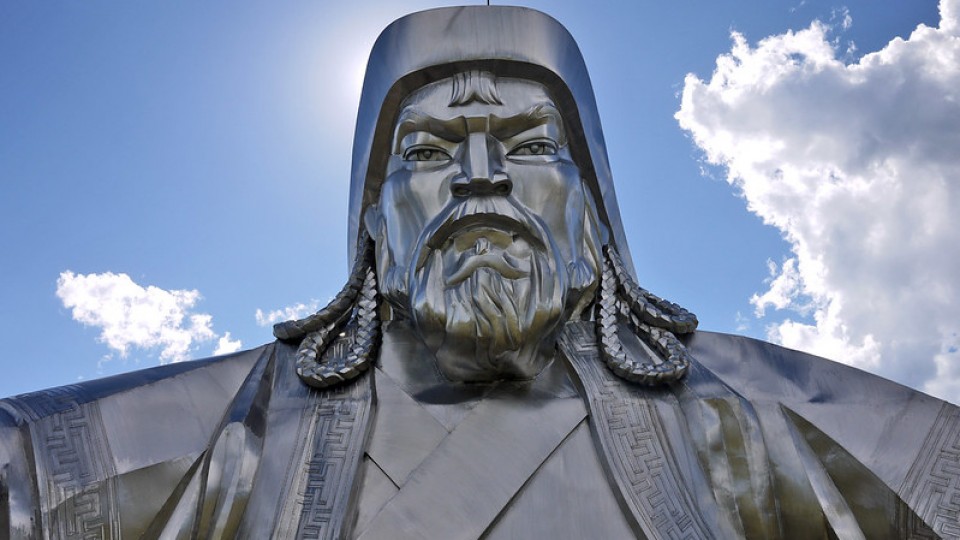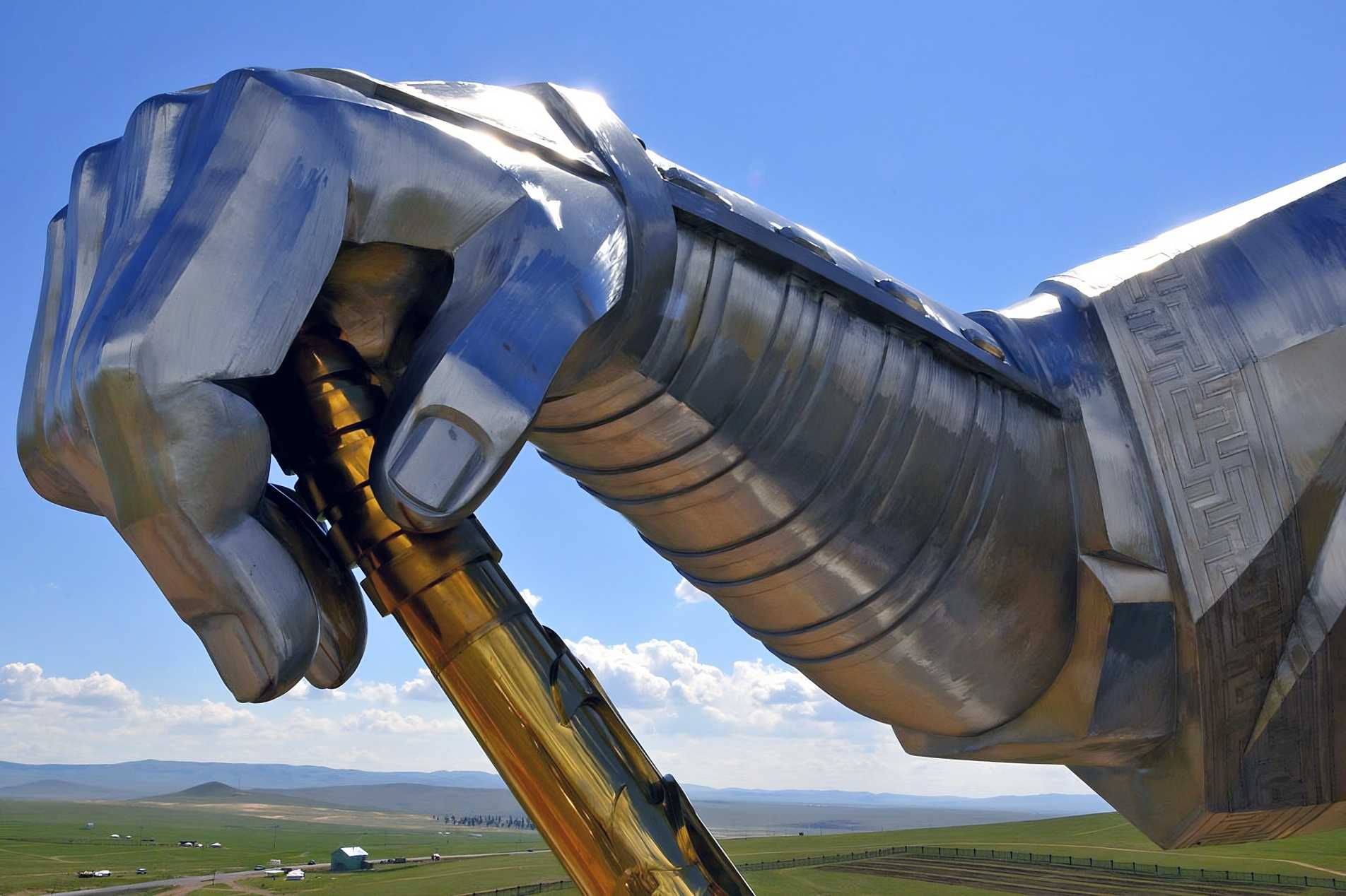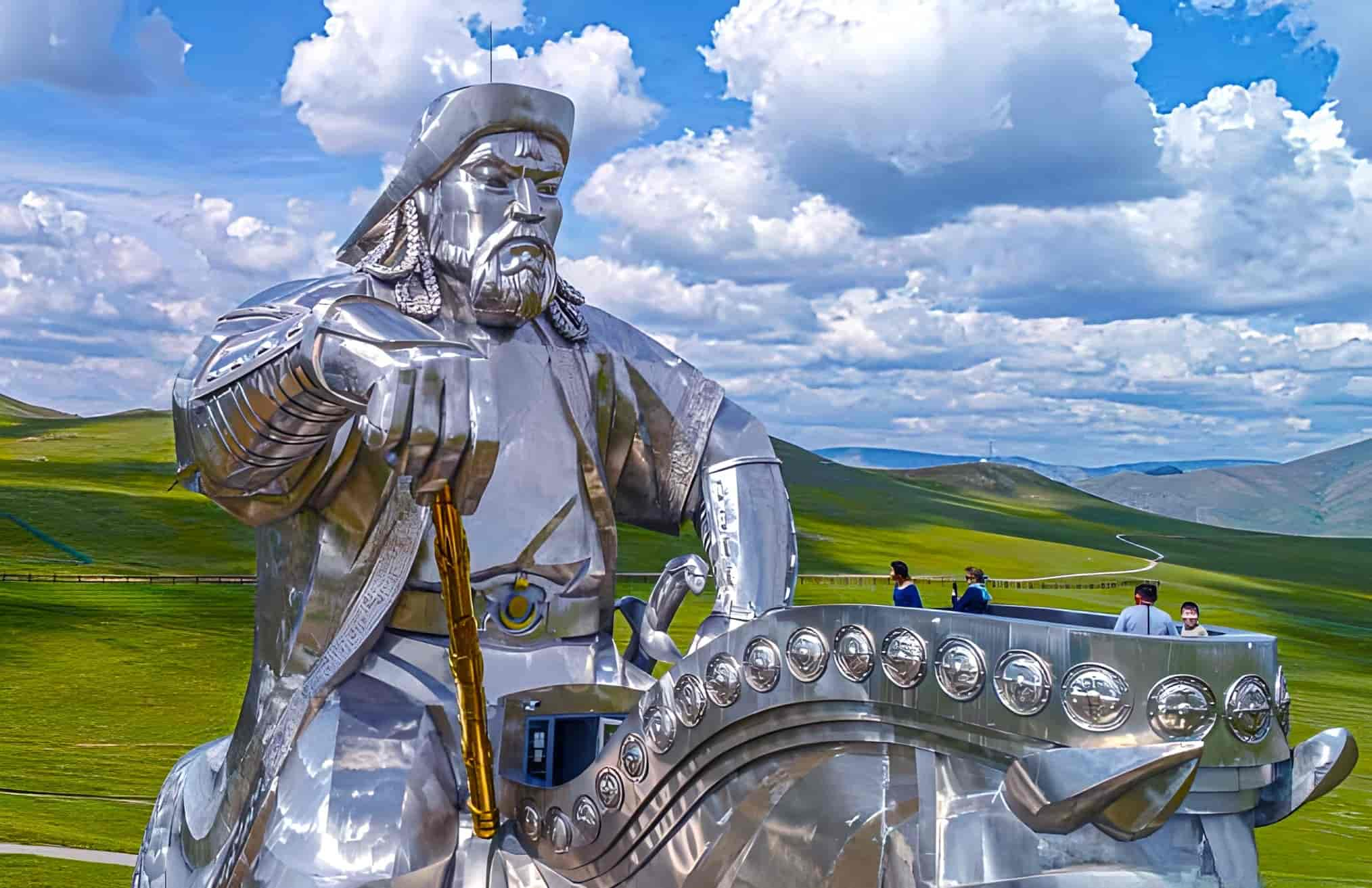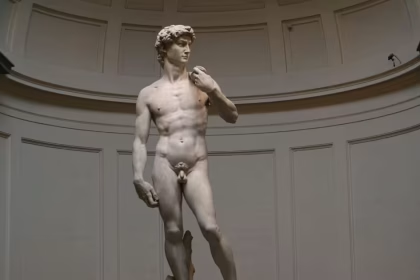Genghis Khan Statue at a Glance
What is the Genghis Khan statue and where is it located?
The Genghis Khan statue is the tallest equestrian statue in the world and is located 33 miles southeast of Mongolia’s capital, Ulaanbaatar, in an area called Tsonjin Boldog on the banks of the Tuul River.u003cbru003e
What is the height of the Genghis Khan statue and what is it made of?
The Genghis Khan statue is 131 feet (40 m) tall and is made entirely of stainless steel, except for the gold-plated Turko-Mongol saber and Genghis Khan’s whip, which are made of rose gold PVD stainless steel.
What is the significance of the yurt-shaped foundation of the Genghis Khan statue?
The yurt-shaped foundation of the Genghis Khan statue represents the nomadic herding and tent-based nomadic lifestyle that are typical of Mongolia. The monument is meant to honor not just Genghis Khan but the whole Mongolian culture.
How can visitors reach the observation deck of the Genghis Khan statue and what can they see from there?
Visitors can take an elevator up to the exhibition hall located on the horse’s back. In order to reach the head of the horse at the Genghis Khan statue, visitors must first pass through the horse’s chest and neck. Once they do, an observation deck at a height of 98 feet (30 m) with a panoramic bird’s-eye view is revealed. From there, visitors can see the Mongolian steppe and beyond.
Why was the Genghis Khan statue constructed and who designed it?
The Genghis Khan statue was constructed to mark the 800th anniversary of Genghis Khan’s establishment of the Mongol Empire. The architect J. Enkhjargal and the sculptor D. Erdembileg were responsible for designing the statue.
The Genghis Khan Statue is the tallest equestrian statue in the world (the term refers to a mounted horseman). The 131-foot-tall statue lies 33 miles (54 km) southeast of Mongolia’s capital, Ulaanbaatar, in an area called Tsonjin Boldog on the banks of the Tuul River. Tsonjin Boldog was selected as the location of the Genghis Khan Statue on the narrative that the Great Khan discovered a golden whip in this region. This stainless-steel statue is a component of the larger Genghis Khan Statue Complex.
- Genghis Khan Statue at a Glance
- Overview of the Genghis Khan Statue
- History of the Genghis Khan Statue
- The Symbolic Meanings of the Statue Complex
- The Pedestal of the Genghis Khan Statue
- The Recreational Area Inside the Complex
- Cost of the Genghis Khan Statue Complex
- Location of the Genghis Khan Statue
- Competitors to the Statue
- Significance of the Genghis Khan Statue
“When a Mongol grabs his whip, he can rule the whole globe,” the legend of Tsonjin Boldog reads.

The Great Khan and his horse are looking sternly to the east, in the direction of his birthplace. If you find yourself lost on the Mongolian steppe, all you have to do is locate the statue to determine your way home. Because just like the enemies he formerly hunted, the Genghis Khan Statue can be seen from 6.2 miles (10 km) away.
See also: How Tall Was Genghis Khan?
Overview of the Genghis Khan Statue
Genghis Khan, not Alexander the Great, is considered by many historians to be the greatest conqueror in history. The architect J. Enkhjargal and the sculptor D. Erdembileg were responsible for designing the Genghis Khan Statue.
The construction of the statue began in 2006 and was completed on September 26, 2008. The monument is situated in a broad space atop the hill, and stairs lead up to it.
This sky-high monument features a man who built a great empire that occupied almost the entire known world.

The whole Genghis Khan Statue is 131 feet (40 m) tall. The monument is comprised of a 98-foot-tall (30 m) statue of Genghis Khan on horseback and a 33-foot-tall (10 m) circular base. The base is shaped like a traditional Mongolian yurt and is utilized as a museum.
The statue’s yurt-shaped foundation is designed to represent the nomadic herding and tent-based nomadic lifestyle that are typical of Mongolia. The monument is meant to honor not just Genghis Khan but the whole Mongolian culture.
The Mongol emperor is holding his golden whip in his right hand. The whip has a rose gold PVD stainless steel construction. Based on images of Genghis Khan in Mongolian art, the statue was created to be as historically accurate as possible.

However, the statue’s depiction of Genghis Khan’s face is somewhat generic and not entirely accurate. This is because no one can recall his exact appearance.
See also: How Many Wives Did Genghis Khan Have?
The huge monument weighs 250 tons and is made completely of stainless steel, except for the Khan’s whip and the Turko-Mongol saber, which is gold-plated and features an eagle head.

Because of that, when illuminated by artificial lights at night, the statue appears shinier than it does in natural sunlight. The metal sheet of the statue will be replaced once every 13 years.
Nine sculptures of Genghis Khan’s generals adorn the complex’s entrance since “9” is the lucky number in Mongolian culture. The Genghis Khan Statue is a national symbol of Mongolia in the same way that the Eiffel Tower, the Statue of Liberty, the Great Wall of China, and the Taj Mahal are for their respective nations.
The emblem of the Mongol Empire flag is visible on the belt of the Genghis Khan figure.

The Genghis Khan Statue was constructed from stainless steel since a stainless steel statue will not rust or corrode in the presence of most environmental factors. The stainless steel also appeals to sculptors since it can be polished to a mirror quality.
This metal also makes the statue resistant to earthquakes and high winds and ensures that the monument will remain unharmed in the event of a devastating earthquake in Mongolia.
Visitors can take an elevator up to the exhibition hall located on the horse’s back. In order to reach the head of the horse at the Genghis Khan Statue, visitors must first pass through the horse’s chest and neck.
Once they do, an observation deck at a height of 98 feet (30 m) with a panoramic bird’s-eye view is revealed. Be careful not to have any dizziness.

See also: How Many Children Did Genghis Khan Have?
History of the Genghis Khan Statue
The Genghis Khan Statue was erected to mark the 800th anniversary of Genghis Khan’s establishment of the Mongol Empire. A massive monument dedicated to him seems like the perfect way to mark the occasion.
When Soviet troops occupied Mongolia in the 20th century, the removal of Genghis Khan and his legacy from Mongolian history began. The great Mongol leader began to disappear from Mongolian history texts as his achievements were obliterated.

After the Soviet Union withdrew from Mongolia in the early 1990s, Genghis Khan once again rose to prominence. Banknotes and several postage stamps feature his likeness.
It was during this period that a group of Mongolian businesspeople originally presented the concept of a gigantic Genghis Khan statue. Mongolian architects and engineers worked together to create the tallest equestrian statue in the world. The building process started in 2006 and ended in 2008.
The Symbolic Meanings of the Statue Complex
The direction the monument faces, east, is symbolic of the direction Chinggis Khaan’s life began. The 33-foot-tall pedestal museum under the Genghis Khan Statue features 36 pillars, which represent the 36 Great Khans of the Mongol Empire.

According to the plan, around two hundred yurts (Turkic-Mongol tents) will be set up around the Genghis Khan Statue to create a micro-kingdom. The arrangement of these tents will be inspired by the horse brand markings used by Mongol tribes in the 13th century.
The monument can be circumnavigated on horseback to honor the Mongolian horse riders. At the camp, you can take a picture wearing Mongolian military armor.
The Pedestal of the Genghis Khan Statue

The pedestal of the Genghis Khan Statue houses a two-story art gallery, a museum of the Xiongnu era, a billiard room, a restaurant, a souvenir shop, and a conference room. Both the huge boot and the whip inside the statue are recorded in the Guinness Book of World Records as the largest of their kind.

Visitors may ride an escalator to the observation platform above the horse’s mane field or explore the cultural museum housed in the statue’s circular base, where they can see a replica of the whip and dine on traditional Mongolian (as well as European) food.
The gallery features a curated collection of works by Mongolian artists, many of which highlight important aspects of Mongolian history and culture.
The Genghis Khan Statue Museum has displays on the Bronze Age and the Xiongnu culture of Mongolia. Items like belt buckles, knives, holy animals, and other ordinary objects are on exhibit every day.
Tools from the 13th and 14th centuries, goldsmith’s crafts, some Nestorian crosses and rosaries, and other items are on exhibit as well. There is a 520-acre (212-hectare) tourist recreation complex next to the museum.
The Recreational Area Inside the Complex

The current theme park features only a few yurts. The theme park is based on the lifestyle of the Mongols in the 13th century, with parts devoted to the military, arts and crafts, Tengrism, the Great Khan, and cattle raising.
A recreational area with 200 tourist yurts—laid up in resemblance to the ancient Mongolian stamps for cattle—is planned to fill the area surrounding the statue in the future. The planners aim to plant 10,000 trees.
A golf course, an artificial lake, and an outdoor theater are all on the list of planned amenities for the recreational area. The total cost of the complex’s development so far is estimated at over 28 billion Mongolian tugriks (MNT).
Parts of the Recreational Area

- Guard stations: Visitors have their tickets inspected at the guard stations, which is located at the complex’s outside edge. Visitors will be greeted by friendly guides and shown around the camp. People can pose for photos while bowing before the white and black coats of arms of the Mongolian Empire as well as while wearing Mongolian military armor.
- Craftsmen’s Camp: While touring the workshops, guests can learn about old techniques used by Mongolian women in the production of felting, quilting, needlework, sewing, and embroidery. Visitors will also observe how barley was processed in the 13th century, learn about the artisan lifestyle through a tour of the blacksmith and carpentry facilities, and more.
- Book House: Visitors to the Book House can have their names inscribed on parchment by medieval scribes and learn about the history of Mongolian writing, the only “vertical script” in the world. In this house, people can learn about the history and culture of the Mongolian people through books originally written in the old Mongolian alphabet.
- Herdsman’s Camp: Participants can sample fermented milk, see dairy products being made, and attend workshops. Visitors can enjoy traditional horse and livestock shows in addition to camel rides. Tourists can take camel rides throughout the region or see traditional horse and cattle shows.
- Shaman’s Lodge: At the Shaman’s Lodge, visitors experience traditional Mongolian shamanic or Tengerism rites, learn about the history of shamanism as the earliest religion in Mongolia, and even dress like a shaman.
- Royal House: In the Royal House, tourists enjoy a wide selection of traditional Mongolian dishes and beverages while seeing the residences of the vice ministers, generals, and queens of the Mongolian royal family.
Cost of the Genghis Khan Statue Complex
The construction cost of the Genghis Khan Statue and the complex is 14,3 billion MNT, or only around 4,100,000 United States dollars. The Mongolian company, Genco Tour Bureau JSC, paid for everything itself. With the recent developments, the overall cost of developing the complex has now exceeded 28 billion MNT, which is equivalent to $8,000,000.
Location of the Genghis Khan Statue

Nalaikh, an administrative district of the capital city, includes the area where the Genghis Khan Statue is situated, which is 33 miles (54 km) east of the capital city of Ulaanbaatar.
The statue is located close to the boundary of Töv Province on the banks of the Tuul River. According to oral tradition, Temujin (Genghis Khan’s actual name) discovered a golden whip in this area while traveling to the Keraites tribe on horseback. To honor the location of his birthplace, the monument faces east.
Competitors to the Statue
More than 15 years after its completion, the Genghis Khan Statue is still the tallest equestrian statue in the world at 131 feet (40 m). In fact, its height surpassed that of the previous record holder, a statue in Uruguay, by more than two times. That statue is of José Gervasio Artigas in Minas, which is 59 feet (18 m) tall and 29 feet (9 m) long.
The only statue with the potential to surpass the Genghis Khan Statue as the tallest equestrian in the world was Shiv Smarak at 695 feet (212 m) in India. The Shiv Smarak statue was supposed to be erected off the coast of Mumbai, but as of 2023, the project appears to have been halted or cancelled.
Significance of the Genghis Khan Statue
The Genghis Khan Statue is a national symbol of Mongolia in the same way that Christ the Redeemer is to Brazilians, the Eiffel Tower is to French, the Statue of Liberty is to Americans, the Great Wall of China is to Chinese, and the Taj Mahal is to Indians.
Because of its significance as a symbol of Mongolian identity and history, the monument has become a major draw for tourists to the country. It’s also a way to pay homage to Genghis Khan, whom many Mongols regard as their country’s founding father and a hero.
During the 12th and 13th centuries, Genghis Khan was a prominent Mongolian leader and warrior. He is credited with establishing the Mongol Empire, a powerful state that, at its height, extended throughout most of Asia and into Europe, which was the majority of the known world.
The Equestrian Statue of Genghis Khan embodies the importance of Genghis Khan’s legacy in both local and world history.
References
- The Legacy of Genghis Khan: Courtly Art and Culture in Western Asia, 1256-1353 — Google Books
- Genghis Khan Equestrian Statue — Google Arts & Culture
- Archived – Чингис хааны хөшөөт цогцолбор — Touristinfocenter.mn






